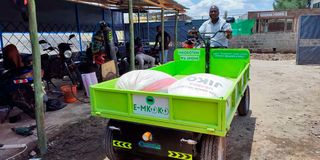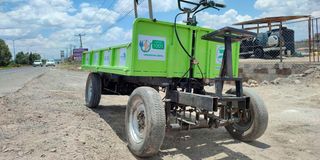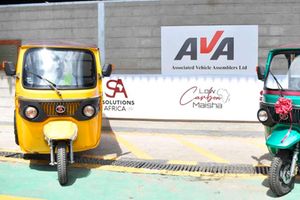
Prof Geoffrey Gitau, founder of Ecomobilus, showcases his latest innovation, an electric powered mkokoteni, now known as eMkoko.
In February 2022, Prof Geoffrey Gitau traveled to represent Zetech University at a research conference in Dubai, where he had a great experience with e-mobility technology.
He was so impressed, he decided to buy an electric scooter. Soon after the purchase, however, he realised how hard it was to ship an e-mobility lithium battery by air, since it is classified as dangerous cargo.
“I forfeited my battery at the airport and shipped the scooter without the battery. Later on, it was hard to obtain a replacement battery anywhere locally and even in Dubai,” he recalls.
He finally decided to build one using lithium cells and components recovered from laptop batteries, following self-taught online lessons.
Since then, with his co-founder Paul Waweru, a physicist, they have been working to perfect building lithium batteries for Emobility. So far, they have built them in various profiles for bicycles, scooters, boda bodas, tuk tuks; and for lighting mama mboga stands, as well as domestic lighting, barbershop and salon businesses.
Prof Gitau, who is a PhD holder in Entrepreneurship, says his first product in February 2022 was just a 36V lithium battery for his scooter, which cost Sh10,000, much less than an import that cost Sh25,000.
“What many people don’t know is that an Electric Vehicle simply comprises an electric powertrain and a battery energy system that powers it,” he remarks.
For a motorcycle, the powertrain is either a hub motor or a mid-drive motor. A hub motor is the easiest to implement because it is mounted in the rear wheel or on rare occasions in the front wheel. The battery is mounted at an appropriate location in the motorcycle chassis, however, hub motors pose a challenge when the rim or the hub itself is broken. You have to replace both.
“A mid-drive motor separates them; the wheel and the motor, and is connected to the drive wheel by either a chain, belt, or gearbox. This will always be slightly expensive but a better choice in the end,”
Tuk tuk conversion, however, is similar except that the option of mid-drive is replaced by a differential unit. It is therefore a little more expensive to convert than for a motorcycle,” he adds.
Apart from the simple knowledge of the electric vehicles’ components, a lot of mechanical work is required to do the right alignment and fix these components because of the need to understand them.
These include the gearing ratios, power rating matching of components, programming of the drive controller and its right sizing, power conversion from high voltage direct current to normal 12V direct current needed for lights, and standard vehicle controls.
“It calls for patience and extreme care, because a mistake may cost one loss of a very expensive part, the vehicle, or even risk injuries to the users,” he adds.

The electric powered mkokoteni, now known as eMkoko.
The process is also one-way and irreversible and you must guarantee the owner of the vehicle a better state than their earlier state.
Users must be trained on the maintenance of the converted electric vehicle because there are unique management skills required such as motoring its power consumption, cleaning it, fixing it, and charging it.
“The cost for converting from a fuel to electric powered motorcycle is Sh115,000 for mid-drive motor and Sh95,000 for hub motor. One for a tuk tuk costs between Sh165,000-to Sh195,000 depending on the rating of the motor installed and the battery,” explains Prof Gitau.
His latest project is the eMkoko. This is an electric mkokoteni with a load weight of 500 kilograms.
“We built it from scratch including the chassis, the loading tray, and the battery. The other components were obtained from garages around the Eastern bypass area that include the braking systems like the hand brakes, suspension leaf springs, and other essential parts,” he adds.
New parts added include the controller, lighting system, and hydraulics breaks. The eMkoko has been undergoing trial in a real-life user environment in Mbeere, in Embu County, by an innovator providing irrigation as a service, a concept similar to Uber for Irrigation.
“Farmers at Gachuriri in Embu County, who cannot afford (to do) their own irrigation book irrigation service and eMkoko is used to transport solar panels for irrigation together with pumps, pipes, and other irrigation equipment.”
The eMkoko now covers 60 square kilometers up from 10 square kilometers served earlier with the traditional mkokoteni.
“It has also become easier for female workers on the farm to ride the eMkoko and create jobs for themselves as well,” adds Prof Gitau.
The user is currently relying on solar power for recharging.
The plan is to carry out the pilot phase with 100 units in Nairobi and Kiambu by end of 2025.
“We aim to produce 1,000 units targeting all the counties in Kenya in our 2026-2027 plan,” he says.
The innovation is envisioned to create decent jobs and alleviate problems of climate change by displacing alternative petrol-powered light trucks, tuk tuks, and bodabodas, while transiting these operators to more productive and cost-effective transport utility. The professor adds that they are looking for investors to fund their piloting between 2025 and 2026 and scaling by the 2026-2027 financial year.
“The eMkoko project is a joint project of Kenyatta University, the School of Engineering, and our startup called Ecomobilus Technologies.”
The startup has been incubated at the university’s innovation hub, Chandaria BIIC since 2022.
Prof Gitau says his greatest motivation is to change the narrative of Kenya’s vehicle manufacturing by delivering Kenyan-built vehicles using local talent and achieving his childhood dream of being an industrialist. His goal is to have a regional reach of electrical vehicles into Sub-Saharan Africa and the global market.









